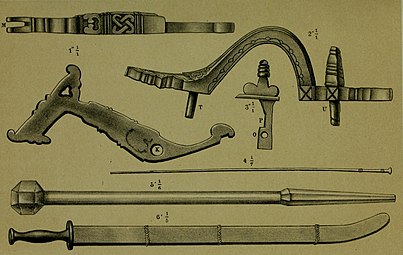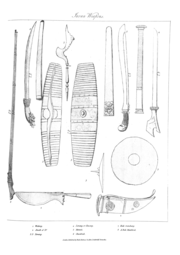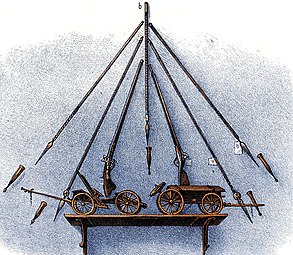Istinggar

Istinggar is a type of matchlock firearm built by the various ethnic groups of the Malay Archipelago . The firearm is a result of Portuguese influence on local weaponry, particularly after the capture of Malacca (1511).[1] Before this type of gun, in the archipelago already existed primitive long gun called bedil, or Java arquebus as the Chinese call it.[citation needed] Most of the specimen in the Malay Peninsula are actually Indonesian in origin, manufactured in the Minangkabau lands of West Sumatra. The states of the Malay Peninsula imported this firearm as it was widely used in their wars.[2]: 57
Etymology[]
The name istinggar comes from the Portuguese word espingarda meaning arquebus or musket. This term then corrupted into astingarda and istingarda, eventually to istinggar.[3] The word has many variations in the archipelago, such as setinggar, satinggar, satenggar, istenggara, astengger, altanggar, astinggal, ispinggar, and tinggar.[4][5][6][7][8][9]: 209 [10]
History[]
The predecessor of firearms, the pole gun (bedil tombak), was recorded as being used by Java in 1413.[11][12]: 245 However the knowledge of making "true" firearms in the archipelago came after the middle of 15th century. It was brought by the Islamic nations of West Asia, most probably the Arabs. The precise year of introduction is unknown, but it may be safely concluded to be no earlier than 1460.[13]: 23 Before the arrival of the Portuguese in Southeast Asia, the Malays already possessed primitive firearms, the Java arquebus.[14] This firearm has a very long barrel (up to 2.2 m in length), and during the Portuguese conquest of Malacca (1511), it is proven to able to penetrate a ship's hull to the other side.[15][13] However the lock mechanism and the barrel of the gun is very crude.[14][16]: 53
The Portuguese in Goa and Malacca independently produced their own matchlock firearms. Starting in the 1513, the tradition of German-Bohemian gun making were merged with Turkish gun making traditions.[17]: 39–41 This resulted in Indo-Portuguese tradition of matchlocks. Indian craftsmen modified the design by introducing a very short, almost pistol-like buttstock held against the cheek, not the shoulder, when aiming. They also reduced the caliber and made the gun lighter and more balanced. This was a hit with the Portuguese who did a lot of fighting aboard ship and on river craft, and valued a more compact gun.[17]: 41 [18]

The Malay gunfounders, compared as being in the same level with those of Germany, quickly adapted these new firearms.[19]: 385 There were 2 different lock mechanisms used in Indo-Portuguese guns. One has a single leaf mainspring of the Lusitanian gun prototypes, which can be found in Ceylon, Malay peninsula, Sumatra, and Vietnam, and the other has a V-shaped mainspring, can be found in Java, Bali, China, Japan, and Korea.[17]: 103–104 [20] The lock mechanism of istinggar is usually made of brass.[21]: 99 The Malays used bamboo covers in their matchlock arquebus barrel and bound them with rattan, to keep them dry in wet weather.[21]: 100 [22]: 53 Istinggar is typically longer than Japanese guns. The absence of a channel for the ramrod indicated that they were used resting on a wall or used from a ship's railing like the lela or rentaka. In this case, the ramrod did not need a compartment.[23] The Malays also made small mallet to drive the musket balls down the barrel.[21]: 99–100
Minangkabau people of interior Sumatra is renowned for their manufacture of gunpowder-based weapons. The manufacture of cannons by Minangkabau people is known before the discovery of Cape of Good Hope by European people (1488).[24]: 347 Iron and steel was produced in their forges, but by the 19th century they became more reliant to the Europeans.[24]: 347 The matchlock arquebus of Minangkabau was dubbed "Istenggara Menangkabowe" (or istinggar Minangkabau, or simply satingga).[9]: 209 [3]: 64 [25]: 277 The production was enough to fulfill local needs, the Minangkabau also exported their firearms to other areas, such as Aceh, Malacca, and Siak Sultanate.[24]: 347 [26] The barrels are made by rolling a flatted bar of iron of proportionate dimensions spirally round a circular rod, and beating it till the parts of the former unite, and the art of boring is probably unknown to them.[24]: 347–348 This manufacture continued even into the 19th century, when matchlock has already been obsolete.[26] A manuscript called Ilmu Bedil (means "knowledge of firearm") is a treatise about this type of istinggar. The Minangkabau also produced other firearm, the terakul (dragoon pistol).[3]: 61 The Batak people used matchlock guns with locks made of copper, and regarded by Marsden as expert marksmen. However the guns of Batak were supplied by Minangkabau traders.[24]: 377–378
The Makassar people of the Kingdom of Gowa, which maintained friendly relationship with the Portuguese since 1528,[27] benefitted considerably from Portuguese assistance in building up its military strength. Converted to Islam in early 1600s, they made holy war (jihad) to its nonbeliever neighbour, the Bugis.[19]: 431 The Makassan were already manufacturing muskets, probably from Portuguese espingarda, sometime in the late 16th or early 17th century. By 18th century, their neighbor (Bugis) produced guns with straight bore and fine inlay work that attracted the admirations of the Europeans.[19]: 384 During years of warfare, Bugis and Makassarese soldiers, dressed in waju rante (chain mail) and carrying muskets which they made themselves, acquired formidable reputation for ferocity and courage.[28]: 209 Between 1603-1606, the Iberian Union troops attacked Ternate twice, and reported muskets and arquebuses were used by the "Moros" (i.e Moors, or muslims).[29]

Eventually, the Istinggar spread to the Muslim controlled areas of the Philippine archipelago, where it was known as "astinggal". The 1613 San Buenaventura Tagalog dictionary defines "astingal" as "arquebus, of the kind they used to use in olden times in their wars and which came from Borneo". This appears to be the first reference to them in northern Luzon.[30] Despite this, the Spaniards never faced any in their encounters in Luzon as they did in Mindanao.[31] In 1609, the Spaniards reported that in Zambales many of the natives handle the arquebuses and muskets quite skilfully, since they have seen the Spaniards use their weapons.[29]
The Hindu inhabitants of Bali and Lombok, being the remnant of Majapahit hindus,[32] are famous for their manufacture of matchlock. In 1800s Alfred Wallace saw two guns of their manufacture, 6 and 7 feet (1.8 and 2.1 m) long, with proportionately large bore. The wooden stock is well made, extended to the front end of the barrel. The barrels were twisted and finished, with silver and gold ornament.[18]: 98 For making the long barrel, the natives use 18 inch (46 cm) pieces of barrel which are first bored small, and then welded together upon a straight iron rod. The whole barrel is then worked with borers of gradually increasing size, and in three days the boring is finished.[33]: 170
For firearms using flintlock mechanism, the inhabitants of Nusantara archipelago is reliant on Western powers, as no local smith could produce such complex component.[34]: cxli [18][35]: 42 and 50 These flintlock firearms are completely different weapon and were known by another name, senapan or senapang, from Dutch word snappaan.[13]: 22 The gun-making areas of Nusantara could make these senapan, the barrel and the wooden part is made locally, but the mechanism is imported from the European colonist.[35]: 42 and 50 [3]: 65 [18] The Javanese was among the earliest to modernize: After the VOC began replacing matchlocks to flintlocks in 1680s, the Javanese already requesting them by 1690s. Flintlock senapan began to appear in Javanese arsenal in early 1700 AD.[16]: 55–56
Gallery[]

Weapons of Central Sumatra, including an istinggar.

Snap matchlock mechanism parts of an istinggar.

Snap matchlock mechanism parts of an istinggar.

Javanese weapons, including a Balinese istinggar (1.9 m long) at the left.

Javanese weapons including lances, istinggar (left), and senapan (right).
See also[]
| Wikimedia Commons has media related to Istinggar. |
- Java arquebus, earlier, more primitive firearm of Nusantara archipelago
- Vietnam arquebus, several type of firearms used by Vietnamese
- Lantaka, light swivel gun of the Malays
- Tanegashima (gun)
References[]
- ^ Andaya, L. Y. 1999, interaction with the outside world and adaptation in Southeast Asian society 1500–1800. In The Cambridge History of Southeast Asia. ed. Nicholas Tarling. Cambridge: Cambridge University Press, 345–401.
- ^ Hasbullah, Wan Mohd Dasuki Wan (September 2013). "Teknologi Istinggar Beberapa Ciri Fizikal dalam Aplikasi Teknikalnya". International Journal of the Malay World and Civilisation (IMAN). 1: 51–59.
- ^ Jump up to: a b c d Dasuki, Wan Mohd (2014). "Malay Manuscripts on Firearms as an Ethnohistorical Source of Malay Firearms Technology". Jurnal Kemanusiaan. 21: 53–71.
- ^ Gibson-Hill, C. A. (July 1953). "Notes on the old Cannon found in Malaya, and known to be of Dutch origin". Journal of the Malayan Branch of the Royal Asiatic Society. 26: 145–174 – via JSTOR.
- ^ Nugroho, Irawan Djoko (2011). Majapahit Peradaban Maritim. Suluh Nuswantara Bakti. ISBN 9786029346008.
- ^ Wilkinson, Richard James (1961). An Abridged Malay-English Dictionary (Romanised). Рипол Классик. ISBN 9785878813563.
- ^ Potet, Jean-Paul G. (2016). Tagalog Borrowings and Cognates.
- ^ Iskandar, Teuku (1958). De Hikajat Atjeh. Gravenhage: KITLV. p. 175.
- ^ Jump up to: a b Newbold, Thomas John (1971). Political and statistical account of the British settlements in the Straits of Malacca volume 2. Singapore: Oxford University Press.
- ^ Bataviaasch Genootschap van Kunsten en Wetenschappen (1779). Verhandelingen van het Bataviaasch Genootschap der Kunsten en Wetenschappen. Museum of Comparative Zoology Harvard University. Batavia : Egbert Heemen.
- ^ Mayers (1876). "Chinese explorations of the Indian Ocean during the fifteenth century". The China Review. IV: p. 178.
- ^ Manguin, Pierre-Yves (1976). "L'Artillerie legere nousantarienne: A propos de six canons conserves dans des collections portugaises". Arts Asiatiques. 32: 233–268. doi:10.3406/arasi.1976.1103.
- ^ Jump up to: a b c Crawfurd, John (1856). A Descriptive Dictionary of the Indian Islands and Adjacent Countries. Bradbury and Evans.
- ^ Jump up to: a b Tiaoyuan, Li (1969). South Vietnamese Notes. Guangju Book Office.
- ^ de Barros, João (1552). Primeira decada da Asia. Lisboa.
- ^ Jump up to: a b Charney, Michael (2004). Southeast Asian Warfare, 1300-1900. BRILL. ISBN 9789047406921.
- ^ Jump up to: a b c The bewitched gun : the introduction of the firearm in the Far East by the Portuguese, by Rainer Daehnhardt 1994.
- ^ Jump up to: a b c d Egerton, W. (1880). An Illustrated Handbook of Indian Arms. W.H. Allen.
- ^ Jump up to: a b c Tarling, Nicholas (1992). The Cambridge History of Southeast Asia: Volume 1, From Early Times to C.1800. Cambridge University Press. ISBN 9780521355056.
- ^ "Firearms and Artillery in Pre-Colonial Vietnam « Seven Stars Trading Company". Retrieved 2020-10-03.
- ^ Jump up to: a b c Gardner, G. B. (1936). Keris and Other Malay Weapons. Singapore: Progressive Publishing Company.
- ^ Charney, Michael (2004). Southeast Asian Warfare, 1300-1900. BRILL. ISBN 9789047406921.
- ^ "Fine Malay matchlock musket | Mandarin Mansion". www.mandarinmansion.com. Retrieved 2020-08-23.
- ^ Jump up to: a b c d e Marsden, William (1811). The History of Sumatra, containing an account of the government, laws, customs, and manners of the native inhabitants. Longman, Hurst, Rees, Orme, and Brown.
- ^ William, Marsden (1783). The history of Sumatra : containing an account of the government, laws, customs, and manners of the native inhabitants, with a description of the natural production, and a relation of the ancient political state of that island. London: W. Marsden.
- ^ Jump up to: a b Putra, Yudhistira Dwi (25 April 2018). "Bedil di Ujung Sejarah Senjata Api Melayu". Era Indonesia. Retrieved 12 February 2020.
- ^ Noteboom, Christiaan (1952). "Galeien in Azië". Bijdragen tot de Taal-, Land- en Volkenkunde. 108: 365–380. doi:10.1163/22134379-90002424.
- ^ Marsden, William (1966). A History of Sumatra. Kuala Lumpur.
- ^ Jump up to: a b Bourne, Edward Gaylord (2005). The Philippine Islands, 1493-1898 — Volume 16 of 55, year 1609.
- ^ Scott, William Henry. "Cracks in the Parchment Curtain" (1978): 177. Cite journal requires
|journal=(help) - ^ Scott, William Henry (1994). "Chapter 12 - Tagalog Society and Religion". Barangay: Sixteenth-century Philippine Culture and Society. Ateneo University Press. p. 232. ISBN 9789715501354.
The Bornean arquebus (astingal) was also known, but the Spaniards seem never to have faced any in Luzon encounters as they did in Mindanao.
- ^ Schoppert, P., Damais, S. (1997). Didier Millet (ed.). Java Style. Paris: Periplus Editions. pp. 33–34. ISBN 962-593-232-1.CS1 maint: multiple names: authors list (link)
- ^ Wallace, Alfred Russel (1872). The Malay Archipelago: The Land of the Orang-utan and the Bird of Paradise : a Narrative of Travel, with Studies of Man and Nature 4th edition. Macmillan.
- ^ Raffles, Sir Thomas Stamford (1830). The History of Java, Volume 2. Java: J. Murray.
- ^ Jump up to: a b Tarling, Nicholas (1999). The Cambridge History of Southeast Asia. Cambridge University Press. ISBN 978-0-521-66370-0.
- Early firearms
- Malay culture
- Muskets
- Weapons of Indonesia
- Weapons of Java
- Weapons of the Philippines
- 16th-century military history
- Weapons of Malaysia
- Firearms of Indonesia







